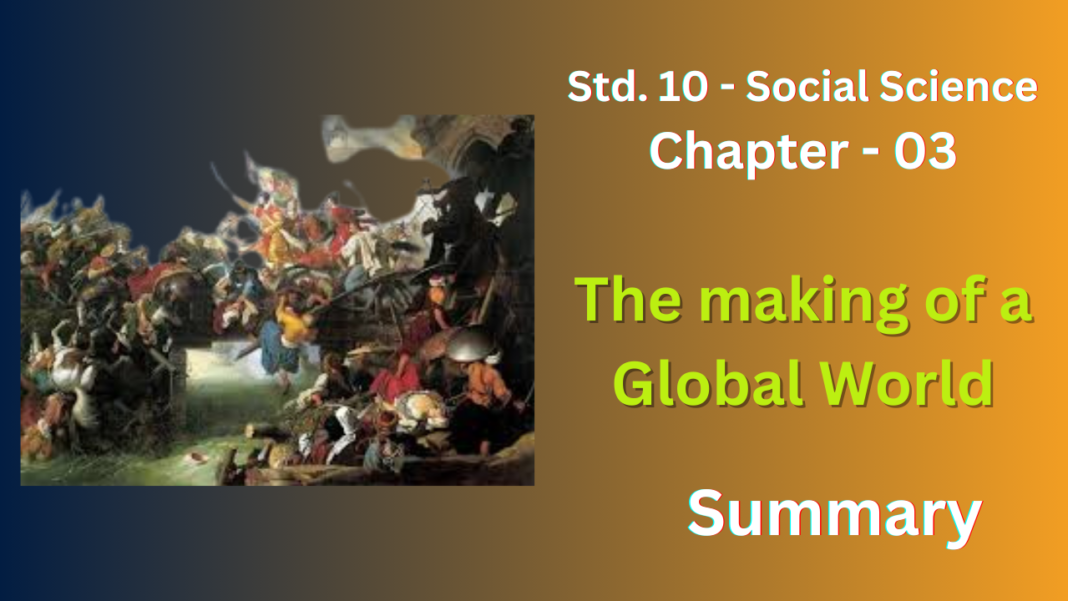NCERT Solutions for Class 10 History Chapter 3
The The making of a Global World chapter in your 10th standard history textbook explores how our world became increasingly interconnected throughout history. Here are the key points:
Early Connections:
- Even in ancient times, there were trade routes and cultural exchanges happening across continents. For example, the Indus Valley Civilization had connections with West Asia.
Rise of Industrialization:
- The Industrial Revolution in the 19th century dramatically increased the production of goods. This led to a need for new markets and raw materials, further pushing for global trade networks.
Factors Leading to Globalization:
- Economic factors: Improved transportation (ships, railways) and communication (telegraph) facilitated faster movement of goods, people, and ideas.
- Political factors: European colonialism established global empires, leading to a spread of European ideas and cultures in colonized regions.
Impact of Globalization:
- Spread of ideas: Western ideas like democracy, nationalism, and socialism spread across the globe, influencing independence movements and social reforms.
- Cultural Exchange: Different cultures interacted, leading to a cross-pollination of art, literature, and cuisine.
- Exploitation and Inequality: Colonialism also resulted in the exploitation of resources and people in colonized countries, creating inequalities in wealth and power.
The Making of a Global World emphasizes that globalization has been a long process with both positive and negative consequences. It has fostered connections, trade, and cultural exchange, but it has also led to economic disparities and power imbalances.
NCERT Solutions for Class 10 History Chapter 3 The making of a Global World
Exercise
Write in brief (The Making of a Global World)
1. Give two examples of different types of global exchanges which took place before the 17th century, choosing one example from Asia, and one from America.
Ans :
- Asia: The Silk Road: This vast network of trade routes stretching from China to the Mediterranean Sea facilitated the exchange of goods, technologies, and ideas for centuries before the 17th century. Goods like silk, spices, porcelain, and paper traveled westward, while knowledge of gunpowder, papermaking, and new agricultural techniques flowed eastward.
- Americas: Columbian Exchange: While not exactly “global” in the traditional sense, the voyages of Christopher Columbus in 1492 marked the beginning of a significant exchange between the Americas and Europe. Crops like maize (corn), potatoes, tomatoes, and chili peppers were introduced to Europe, revolutionizing diets and agricultural practices. Conversely, European diseases like smallpox and measles devastated the indigenous populations of the Americas.
2. Explain how the global transfer of disease in the pre-modem world helped in the colonisation of America.
Ans :
The global transfer of disease in the pre-modern world played a crucial role in European colonization of the Americas, acting as an unwitting weapon. Here’s how:
- Lack of Immunity: Native American populations had never been exposed to the diseases brought over by Europeans, such as smallpox, measles, influenza, and bubonic plague. These diseases were highly contagious and often deadly for them, lacking the natural immunity Europeans had developed over centuries of exposure.
- Devastating impact: These diseases spread rapidly through indigenous communities, causing widespread illness and death. Entire villages could be decimated within a short period. This resulted in a significant decline in the Native American population, weakening their resistance to European conquest.
- Reduced Resistance: The population decline due to disease outbreaks left the remaining indigenous people less able to defend their land and way of life. This made it easier for European colonizers to overpower them militarily and establish control over vast territories.
- Psychological Impact: The rapid spread of disease and the high death tolls instilled fear and despair among the indigenous people. This demoralization further weakened their ability to resist European encroachment.
3. Write a note and explain the effects of the following :
(a) The British government’s decision to abolish the Corn Laws.
(b) The coming of rinderpest to Africa.
(c) The death of men of working-age in Europe because of the World War.
(d) The Great Depression on the Indian economy.
(e) The decision of MNCs to relocate production to Asian countries.
Ans :
(a) Abolition of the Corn Laws (Britain):
- Freer Trade: The 1846 repeal of the Corn Laws, which imposed tariffs on imported grain, ushered in an era of free trade in Britain. Food prices fell, benefiting consumers, but put pressure on British farmers who struggled to compete with cheaper foreign imports.
(b) Rinderpest in Africa:
- Devastation for Pastoral Societies: Rinderpest, a deadly cattle plague, swept across Africa in the late 19th century. This wiped out vast herds of cattle, a vital source of food, wealth, and social status for many African communities. It caused widespread famine, social disruption, and weakened communities’ ability to resist European colonization.
(c) World War I Deaths in Europe:
- Labor Shortage and Economic Strain: The massive casualties of World War I, particularly among young men, led to a significant labor shortage across Europe. This impacted industrial production, infrastructure projects, and overall economic growth. Women entered the workforce in greater numbers to fill the gap, but the social fabric was significantly altered. Additionally, the financial burden of war reparations further strained European economies.
(d) The Great Depression on India:
- Crash of Commodity Prices: The worldwide economic downturn of the 1930s severely impacted India, a major exporter of agricultural commodities like cotton and jute. The sharp drop in global demand and prices led to a decline in agricultural incomes and exports, causing hardship for Indian farmers.
- Reduced Investment and Trade: The Depression also led to a decrease in foreign investment in India. Reduced trade flows further weakened the Indian economy, impacting industrial production and job creation.
(e) MNC Relocation to Asia:
- Job Losses in Developed Economies: Multinational corporations (MNCs) relocating production to Asian countries, primarily due to lower labor costs, led to job losses in developed economies like the US and Europe. This contributed to unemployment, wage stagnation, and social unrest in these regions.
- Economic Growth in Asia: The influx of foreign investment and manufacturing facilities in Asian countries like China and India fueled their economic growth. This created new jobs, boosted industrial development, and lifted millions out of poverty. However, concerns arose about labor exploitation and environmental impact in these developing nations.
4. Give two examples from history to show the impact of Science and Technology on food availability.
Ans :
1. The Green Revolution (Mid-20th Century):
- Challenge: In the mid-20th century, global food shortages threatened populations, particularly in developing countries. Traditional agricultural methods struggled to keep pace with a growing population.
- Solution: The Green Revolution introduced a package of scientific advancements aimed at increasing agricultural productivity. This included:
- Development of high-yielding varieties (HYVs) of crops like rice and wheat, bred to produce more grains per plant.
- Increased use of fertilizers and pesticides to boost crop yields and protect them from pests and diseases.
- Improved irrigation techniques to ensure a steady supply of water for crops.
- Impact: The Green Revolution led to a dramatic increase in food production worldwide. This helped to alleviate food shortages and improve food security in many countries. However, the Green Revolution also had drawbacks, such as dependence on chemical inputs, environmental concerns, and potential for increased income inequality.
2. Refrigeration Technology (Late 19th Century):
- Challenge: Prior to widespread refrigeration, transporting and storing perishable food items like meat, dairy products, and fruits over long distances was a challenge. This limited access to fresh, nutritious food for many people.
- Solution: The development of reliable and efficient refrigeration technology in the late 19th century revolutionized food transportation and storage. This allowed for:
- Transportation of perishable foods over long distances without spoilage.
- Creation of national and international food markets, increasing the variety of fresh food available to consumers.
- Development of large-scale food processing and distribution networks.
- Impact: Refrigeration technology significantly increased food availability and variety. It improved access to essential nutrients for people and contributed to the growth of the global food industry. However, reliance on cold-chain logistics and increased energy consumption are some of the downsides associated with this technology.
5. What is meant by the Bretton Woods Agreement ?
Ans : The Bretton Woods Agreement (1944) aimed to create a stable global economy after WWII. It set fixed exchange rates (currencies pegged to the US dollar, which was pegged to gold) and established two key institutions:
- IMF: Monitors exchange rates, lends money to struggling countries.
- World Bank: Provides financial assistance for reconstruction and development projects.
The system promoted stability and trade for decades, but eventually collapsed due to limitations (like difficulty maintaining fixed rates). It still left a big footprint with the IMF and World Bank shaping global finance today.
6. Imagine that you are an indentured Indian labourer in the Caribbean. Drawing from the details in this chapter, write a letter to your family describing your life and feelings.
Ans :
Dearest Amma and Abba,
My hands are rough and calloused, a far cry from the soft earth I used to tend back home. The sun here in Trinidad is a relentless tyrant, beating down on us from dawn till dusk. Sweat soaks my thin kurta every day, leaving a salty residue on my skin.
We live in small, cramped barracks, far from the lush fields where we toil. The food is strange, mostly sweet potatoes and watery soup, a pale imitation of the warm rotis and lentil curries we used to share. Sleep comes only after the day’s aches and pains have subsided, and even then, dreams of home often turn into nightmares of the endless cane rows.
The work is brutal. We hack at the sugarcane with heavy machetes, the air thick with the sweet, cloying scent. The overseer, a man with a cruel smile and a whip that cracks like a gunshot, pushes us ever harder. We are spoken to like beasts of burden, not human beings.
Yet, amidst the hardship, there’s a flicker of hope. We, the coolie laborers, find solace in each other. We share stories from home, sing songs in our mother tongue under the starlit sky, and dream of the day our indenture will be over. Some whisper of escape to the wild jungles, but fear of the unknown keeps most of us tethered to this harsh reality.
I yearn for your touch, Amma, for the warmth of your embrace. I miss the stories you used to tell under the banyan tree, Abba. Will I ever see you again? Will this land ever feel like home?
These are the questions that plague my mind each night. But I hold onto the promise we made – a new life for our family. I work with gritted teeth, saving every penny I can, so that when the five years are over, we can return with our heads held high, and perhaps, buy a small piece of land back home.
Please write back soon, and tell me everything about the village. Your letters are the only connection I have to the life I left behind.
With love and longing,
Your Son,
(Your Name)
7. Explain the three types of movements or flows within the international economic exchange. Find one example of each type of flow which involved India and Indians, and write a short account of it.
Ans :
- Trade Flows (Flow of Goods): This refers to the exchange of physical goods between countries.
- Example: Indian Textiles and British Industrial Goods: In the pre-modern era, India was a major exporter of textiles like cotton cloth and silk. These were highly valued in Europe, particularly Britain. After the Industrial Revolution, Britain began exporting large quantities of mill-made cloth to India, undercutting the Indian textile industry. This shift from exporter to importer of textiles exemplifies the changing dynamics of trade flows.
- Human Capital Flows (Flow of People): This refers to the movement of people across borders for work or education.
- Example: Indentured Labor Migration: During the 19th century, a large number of Indians were recruited as indentured laborers to work on plantations in British colonies like Fiji, Mauritius, and the Caribbean islands. These migrants signed contracts to work for a fixed period under harsh conditions. This system of indentured labor addressed a labor shortage in the colonies but subjected Indians to exploitation and hardship.
- Capital Flows (Flow of Investments): This refers to the movement of money across borders for investment purposes.
- Example: Indian Chettiars and Southeast Asian Economies: The Chettiars, a merchant community from Tamil Nadu, played a significant role in financing trade and plantations in Southeast Asia during the colonial era. They provided loans to local businesses and rulers, influencing the economic development of the region. This demonstrates how capital flows from India contributed to economic activity elsewhere.
8. Explain the cause of the Great Depression.
Ans : The Great Depression wasn’t a one-hitter. It was a combination of punches:
- Stock Market Crash (1929): Investors lost big, wiping out savings and shaking confidence.
- Unequal Income: Most people had low wages and limited savings, making them vulnerable.
- Overproduction and Weak Demand: Factories made too much stuff, but people couldn’t afford to buy it.
- Banking System Failures: Banks collapsed, restricting credit and hurting investment.
- Gold Standard: Limited governments’ ability to fight the Depression through economic measures.
These factors all piled on, leading to a decade of economic hardship.
9. (i) Explain what referred to as the G-77 countries.
(ii) In what ways can G-77 be seen as a reaction to the activities of the Bretton Woods Twins ?
Ans : G-77 and the Reaction to Bretton Woods Twins
(i) G-77 Countries:
The Group of 77 (G-77) is a coalition of developing countries established in 1964 at the United Nations Conference on Trade and Development (UNCTAD). Originally starting with 77 members, it has grown to include over 130 developing nations. The G-77 acts as a collective voice for these countries in international economic forums, advocating for their interests related to:
- Trade
- Development assistance
- Debt relief
- Commodity prices
- Access to technology and resources
(ii) G-77 as a Reaction to Bretton Woods Twins:
The Bretton Woods Agreement (1944) established two key institutions:
- International Monetary Fund (IMF): Focused on promoting international monetary cooperation and financial stability.
- World Bank (IBRD): Aimed to provide loans for post-war reconstruction and development projects.
The G-77 can be seen as a reaction to the perceived shortcomings of the Bretton Woods system in several ways:
- Dominance of Developed Countries: The Bretton Woods institutions were largely controlled by developed nations, particularly the US. Developing countries felt their voices and specific needs were not adequately represented.
- Focus on Stability over Growth: The G-77 argued that the Bretton Woods system prioritized financial stability over fostering economic growth in developing countries. They advocated for policies that would address issues like poverty, hunger, and infrastructure development.
- Unequal Benefits: Developing countries felt they didn’t benefit equally from the Bretton Woods system. The G-77 pushed for a more equitable distribution of resources and opportunities for development.
Limited Decision-Making Power: The G-77 aimed to give developing countries a stronger collective voice in shaping international economic policies and institutions.
NCERT Solutions for Class 10 History Chapter 3 The making of a Global World
FAQs
What is the focus of NCERT Solutions for Class 10 History Chapter 3 The Making of a Global World?
NCERT Solutions for Class 10 History Chapter 3, “The Making of a Global World,” focuses on the historical processes that contributed to the formation of the modern global world.
How did trade influence the making of a global world according to NCERT Solutions for Class 10 History Chapter 3 The Making of a Global World ?
In The Making of a Global World trade played a significant role in the making of a global world by connecting different regions and facilitating the exchange of goods, ideas, and cultures.
What were the main factors that contributed to European colonization as explained in NCERT Solutions for Class 10 History Chapter 3 The Making of a Global World?
The main factors that contributed to European colonization include the desire for new trade routes, the search for precious metals and resources, the spread of Christianity, and the pursuit of political and economic power
How did the Industrial Revolution affect global trade according to NCERT Solutions for Class 10 History Chapter 3 The Making of a Global World?
The Industrial Revolution dramatically increased production capacity and technological advancements, leading to the expansion of global trade.
What impact did colonization have on the colonized regions as discussed in NCERT Solutions for Class 10 History Chapter 3 The Making of a Global World?
Colonization had profound impacts on colonized regions, including the exploitation of natural resources, cultural changes, economic dependency, and social disruption.
What role did the slave trade play in the global economy according to NCERT Solutions for Class 10 History Chapter 3 The Making of a Global World?
The slave trade was a crucial part of the global economy during the early modern period. It provided labor for plantations in the Americas, which were key suppliers of commodities like sugar, cotton, and tobacco.
How did global interconnectedness influence cultural exchanges as described in NCERT Solutions for Class 10 History Chapter 3 The Making of a Global World?
Global interconnectedness facilitated cultural exchanges by bringing people from different regions into contact. This led to the spread of ideas, technologies, and cultural practices, resulting in a more interconnected and diverse global culture.
What were the economic impacts of global trade on Europe and Asia according to NCERT Solutions for Class 10 History Chapter 3 The Making of a Global World?
Global trade brought significant economic benefits to Europe, including wealth accumulation and the growth of merchant and industrial classes.









